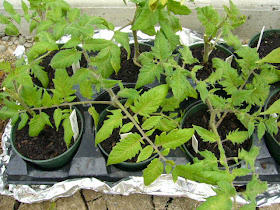 |
| Trading Time at the Bird Ranch for Wayward Heirlooms |
Nope -- we're talking "real" tomatoes here.
So -- what's on the list? What eight to ten heirloom tomato varieties will round out the heirloom tomato garden in the Bird Back 40 this spring? That's a good question! I don't really know the answer just yet. And this is when "horse tradin' time" comes in.
It's time to check in with other gardeners who have also been nurturing heirloom tomato plants from seed during the cold winter months. The question to them is -- "What You Got?" They return the same question in a coy sort of way. Nobody gives away their hand. This is serious business, friends. It's a bit like five-card stud or any other good hand of poker. Each plant is like a card in a 52-card deck. Some are worth more than others.
 |
| Angela Lyons: Knows her Heirloom Tomatoes |
This "game," which has some fairly loose rules, is already underway thanks to the super-charged and picture-perfect growing techniques of Sacramento Starter Plant Star Angela Lyons. Once again, this lady has enlisted the help of a magic waterbed to grow some magnificent starter plants -- two of which have already been delivered (plus one pepper starter to boot!).
Angela's gift to the Bird Garden this year is an Early Girl -- which has already produced three small tomatoes just since it was planted into its final home five days ago. But the real prize in this exchange? It's not the Early Girl -- it's the Black Cherry starter that came with it. Black Cherry starter plants are ALWAYS in high demand -- and this one has already found a home in in the garden of a shall-not-be-named, high-ranking, political operative.
Ssssh!! We won't tell the Fair Political Practices Commission. Like they read the blog anyway...
 |
| Early Girl is EARLY (no complaints here) |
So -- if you're going to play this game of Heirloom Tomato Horse Tradin' -- best come prepared. Fortunately -- Mother Nature smiled upon the Bird seed starting efforts this year. We didn't lose a single starter to disease. We didn't lose a single plant to hardening off efforts that took place earlier this April. What does this mean? It means Bill and Venus Bird have drawn the proverbial "Full House" in this year's trading game.
Although it can be hard to assign a "point value" in a trading game like this one (everyone's tomato tastes are different) -- there are some general rules that are universally recognized by most heirloom seed starters. They are as follows:
 |
| There's a potato-leaf or two in here somewhere! |
BLACK TOMATOES: Black tomatoes are legendary for their size shape, color and TASTE. The Black Cherry heirloom is -- as I've already related -- highly prized. But it's not the only black tomato on the prized heirloom tomato list. There are others. Why are they so special? It might be due to the fact that you can trace the history of black tomatoes to the Crimean Peninsula. Others defer to the taste. Japanese Black Trifele, for example, is highly prized. Other growers have developed a passion for Black Krim tomatoes. Black tomatoes are good trading partners.
 |
| A Livingston Original? Mebbe... |
TOMATOES WITH HISTORY: Tomatoes with well-doccumented histories such as Cherokee Purple (grown by Cherokee Indian tribes) and Mortgage Lifter (wondeful story on Radiator Charlie here) are highly prized by heirloom growers. Others on this list include Dr. Wyche's Yellow (fertlized by circus animals) or Homer Fike's Yellow Oxheart (grown by, guess? Homer Fike!). If you've grown a starter plant with an interesting and well-documented history? Welcome to the horse tradin' table!
TOMATOES YOU CAN'T FIND AT A NURSERY: Most Sacramento area nurseries do an excellent job at stocking heirloom tomato plant starters. Capitol Nursery is one place I go often. I'm sure that Green Acres Nursery offers the same kind of selection. Eisley Nursery in Auburn is another location that also stocks up. But when it comes to heirloom tomato plants, you can't possibly stock them all. There are thousands of varieties to choose from. If you're growing a rare variety that can't be found anywhere else other than your backyard? GAME ON!
So -- it's horse tradin' time peoples. What you got?
 |
| Tomato plants here, Tomato plants there. What you got? |
So -- it's horse tradin' time peoples. What you got?

































